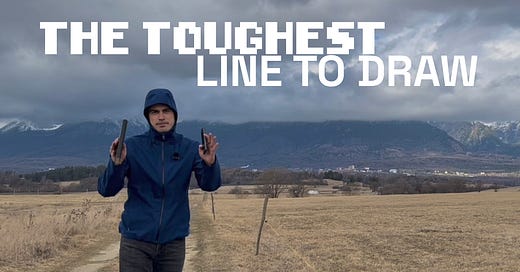Drawing Boundaries to Define Your Digital Life
Learn how drawing intentional boundaries with technology can simplify your digital life, sharpen your focus, and take the first steps toward tech independence. Discover how to choose tools.
Prerequisites
Reflect on Focus: If you haven’t yet, read the previous post From Lost in Tech to Found in Focus to understand how intentional systems help reclaim attention.
Starting from Scratch: Embracing a blank slate approach.
Living an Intentional Lifestyle: Grounding decisions in purpose and awareness.
Introduction
We introduced a single trusted system with friction that helped us slow down and eliminate endless distractions that were ripping our lives apart. Focus is the new game we're playing, and achieving our personal goals is our most important target. Through reflection habits, we're now aware of cycles (daily, weekly, monthly) that help us realign our goals consistently. We've become truly intentional with our lives—the foundation for living Free With Tech.
This is the moment we realize that technology is an extension, not the foundation, of our well-being. There is now a clear boundary between us (paper) and tech (tools). This clarity makes it easier to decide which digital tools stay and which ones must go.
You can also watch the video:
Main Areas of Life
Every app serves a purpose in one of three main areas of life: health, wealth, and relationships. By practicing self-awareness, we've become sensitive to whether an app contributes positively to these areas. This sensitivity guides our next steps in Digital Minimalism—adopting a minimal set of tools that amplify our abilities.
The goal is to keep paper as the foundation, which helps create a visible boundary between ourselves and technology. This foundation provides the flexibility to expand into tech independence later.
Friction
Friction is a double-edged sword. It can either help us stay present or become a chore. Here are some reflection questions to navigate this:
Is my journaling layout too messy and hard to manage? Could it be improved, or is digital a must?
Is there computation I could leverage to make life easier?
To stay tech independent, is it helpful to duplicate information? For instance, capturing habits on a phone during the day and rewriting them in a journal during reflection for peace of mind?
These questions helped me introduce digital tools only when they were necessary and beneficial. Friction maintains focus in our hands while amplifying progress toward goals. It has its place if we value independence and privacy. Writing by hand also strengthens reasoning.
Focus
Some apps are designed to steal time and attention—our most valuable resources. They don't belong in our toolset unless heavily controlled:
Adding Friction: Require authentication before access, limit screen time, or uninstall them from daily-use devices.
Permanent Deletion: Delete apps that consistently drain energy. If they don't offer fulfillment or value, they don't deserve space.
Intentional Use: Even helpful apps can become distractions. Strong journaling habits help evaluate whether an app is truly aiding progress or becoming a subtle time thief.
Cycles
Self-awareness teaches us that cycles are inevitable. Ignoring them can lead to burnout. Embracing cycles ensures balance. Set up systems (like alarms for reflection) to regularly assess daily, weekly, and monthly progress.
Reflection helps identify patterns, recognize when tools stop serving us, and reset without guilt. Embracing cycles empowers better decision-making, especially about the tools we allow in our lives.
Closing Thoughts
Digital Minimalism deepens our understanding of technology. It lays the groundwork for tech independence through the back-and-forth process of journaling and digital tool evaluation. It also heightens awareness about privacy and the implications of who knows what about us.
These reflections set the stage for next week, where we'll explore tech independence in greater depth.
The choice is yours. Are you ready to become Free With Tech?
If this journey resonates with you, I invite you to take the next step: Sign the Free With Tech Manifesto.
The manifesto is a declaration of tech independence—a commitment to using technology on your terms, not the other way around. By signing, you're not just agreeing with an idea; you're joining a movement toward reclaiming control over your digital life.




